-
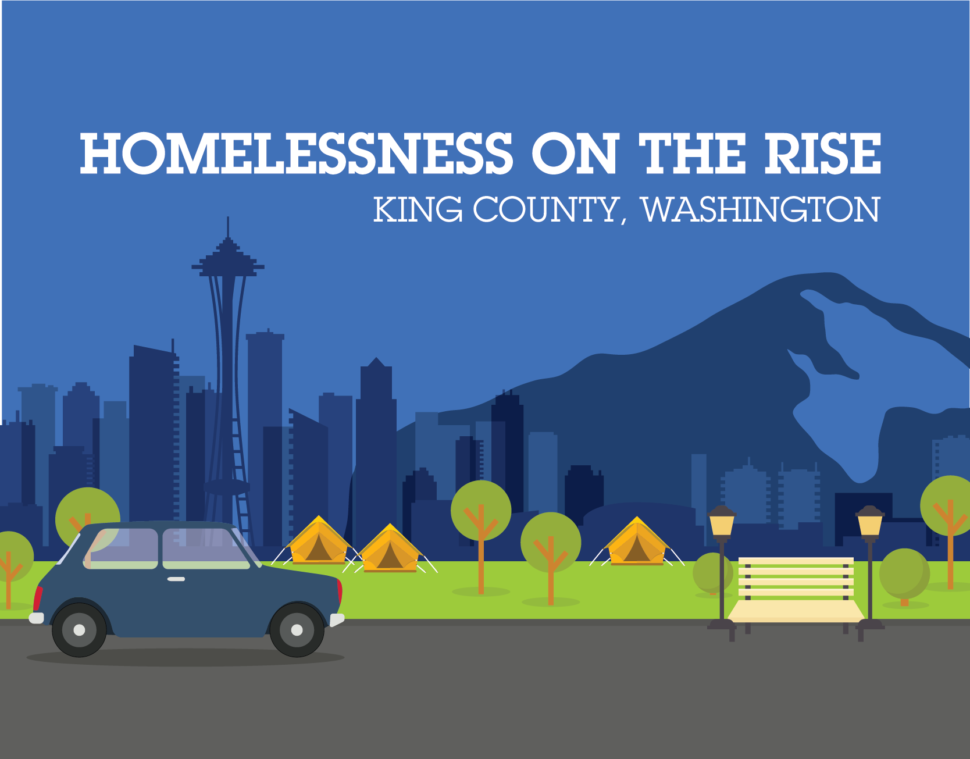
Homelessness in Our Community: WHY our work is needed and HOW you can help.
“Seattle’s homelessness crisis has been years in the making, and its roots run deep, touching racial inequity, economic disparities, mental health treatment, rising housing costs, mental health, addiction, and so much more. We have a responsibility to be honest that this crisis won’t go away overnight. Lasting, meaningful progress will take years. But we still must act – and are acting – to improve life in Seattle.” – Seattle Mayor Jenny Durkan
Scott Greenstone, the Seattle Times “Project Homeless” producer and engagement editor, stated that one way to help the homeless in Seattle is to shorten the wait time to receive mental health and addiction treatment services. “It’s common to wait a week or two – sometimes as much as a month –for an appointment.”
In a report done in 2010 by the U.S. Department of Housing and Urban Development, 34.7{637c4c527fde39f83a380e19107d2ba88ad72607f37ccf8f8b7edeff1c20688c} of sheltered adults who were homeless had chronic substance use issues (SAMHSA) and over 80{637c4c527fde39f83a380e19107d2ba88ad72607f37ccf8f8b7edeff1c20688c} have experienced lifetime alcohol and/or drug problems. According to Seattle Major Jenny A. Durkan’s website, drug overdose is currently the leading cause of death among people who are homeless. More individuals seek detox for heroin than they do alcohol in King County. Due to the lack of beds in Washington (Washington state is ranked 47th in the nation for psychiatric beds per capita), there are more than 150 people on a waitlist for treatment every day! The City of Seattle has allotted a $78,00,000 budget for Homelessness Response in 2018, which includes areas such a shelter, hygiene and outreach, permanent supportive housing, rapid rehousing and diversion, prevention, access to services, operations, and more.
Recovery Beyond’s Climbing Out program has shown an optimistic success rate in helping individuals holistically through recovery by weaving together socialization skills and teamwork with physical activity. As noted in a Federal Strategic Plan to Prevent and End Homelessness, amended in 2015, entitled “Opening Doors”, individuals who are homeless struggle with having a non-existent or frail support network. The interpersonal skills Recovery Beyond teaches are important in the recovery process because they remove the “us vs. them” mentality and increase the likelihood of recovery due to better, supportive relationships. In the past three years, nearly all participants in the program have remained sober. This is incredible. On average, it takes an individual about seven attempts to achieve lasting sobriety.
We need to do everything we can and have all-hands-on-deck if we are going to help homeless individuals in recovery. We are asking for your help: Homelessness can’t be solved overnight. It’s a process of recovery, achieved one individual at a time.
Homelessness continues to be on the rise in King County, according to All Home, an agency that works collaboratively with other organizations and institutions in the county to significantly reduce homelessness. At the time of data collection in 2018, the homeless population in King County was at 12, 211, rising by 469 individuals from the previous year. Over half of the homeless population lives unsheltered, and the remaining live in vehicles, buildings, tents, transitional housing, villages, and emergency shelters.The housing crisis is just one of the many causes of homelessness, but currently grabs more media attention than other causes. Other factors that contribute to homelessness include domestic violence, certain disabilities, untreated mental illness, medical bills, and addiction. Individuals may utilize substances to alleviate the discomforts they are experiencing, whether it be the challenges of an undiagnosed mental health disorder, physical pain, or a coping mechanism for a life situation, such as the death of a loved one or a divorce. There are several factors that can lead to substance use disorders, including social factors, genetic predisposition, availability and tolerance, and other mental health problems.
Will you support our efforts? A monetary donation will support our mission. Please click here to donate.
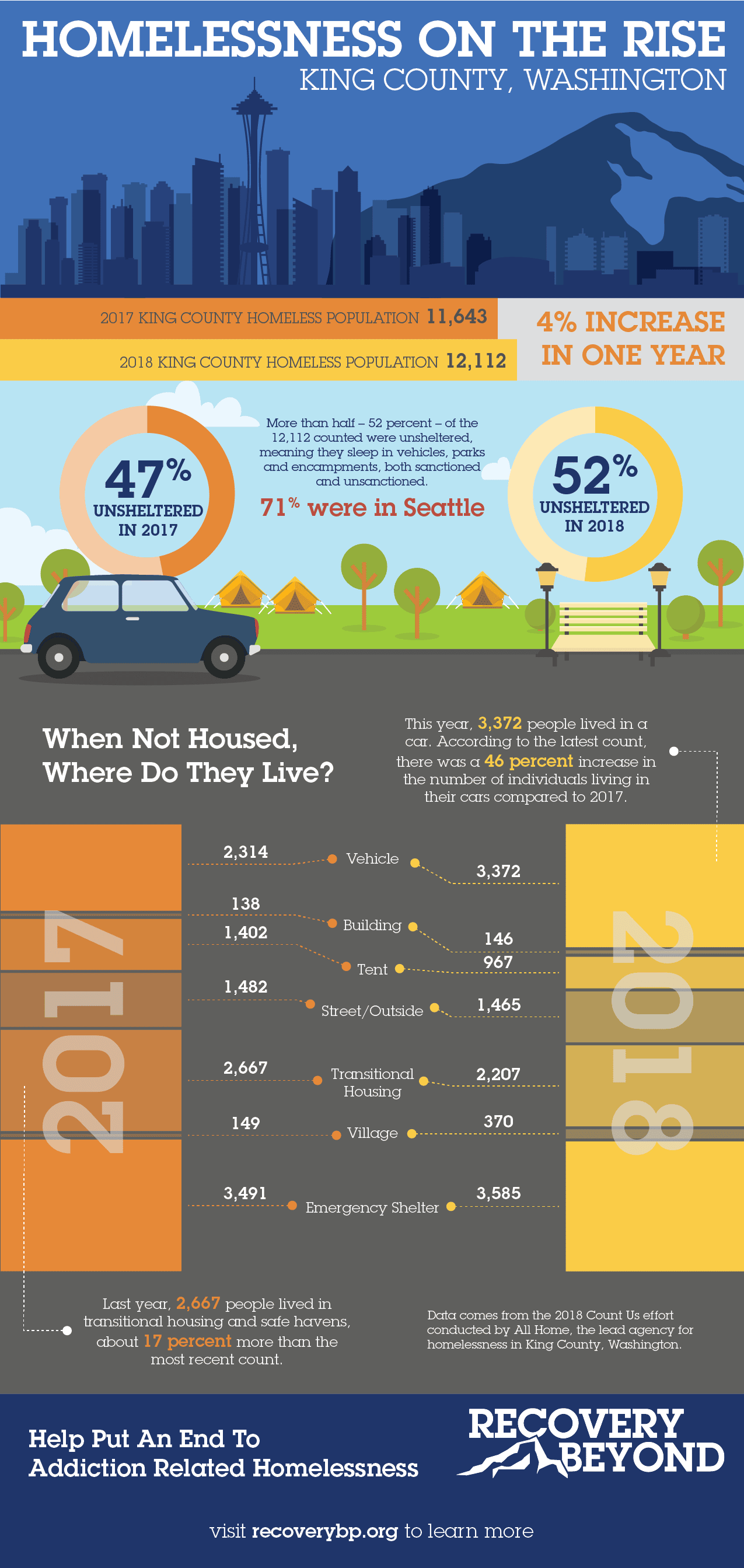
- Current Statistics on the Prevalence and Characteristics of People Experiencing Homelessness in the United States[PDF]. (2011). SAMSHA.
- Greenstone, S. (2017, November 24). One way to help homeless in King County? Shorten the wait for treatment. Retrieved from https://www.seattletimes.com/seattle-news/homeless/one-way-to-help-homeless-in-king-county-shorten-the-wait-for-treatment
- L. (2016, January 21). Homelessness Programs and Resources. Retrieved from https://www.samhsa.gov/homelessness-programs-resources
- Opening Doors[PDF]. (2015, June). United States Interagency Council on Homelessness.
- The Roots of the Crisis. (n.d.). Retrieved July 4, 2018, from https://www.seattle.gov/homelessness/the-roots-of-the-crisis
0 -
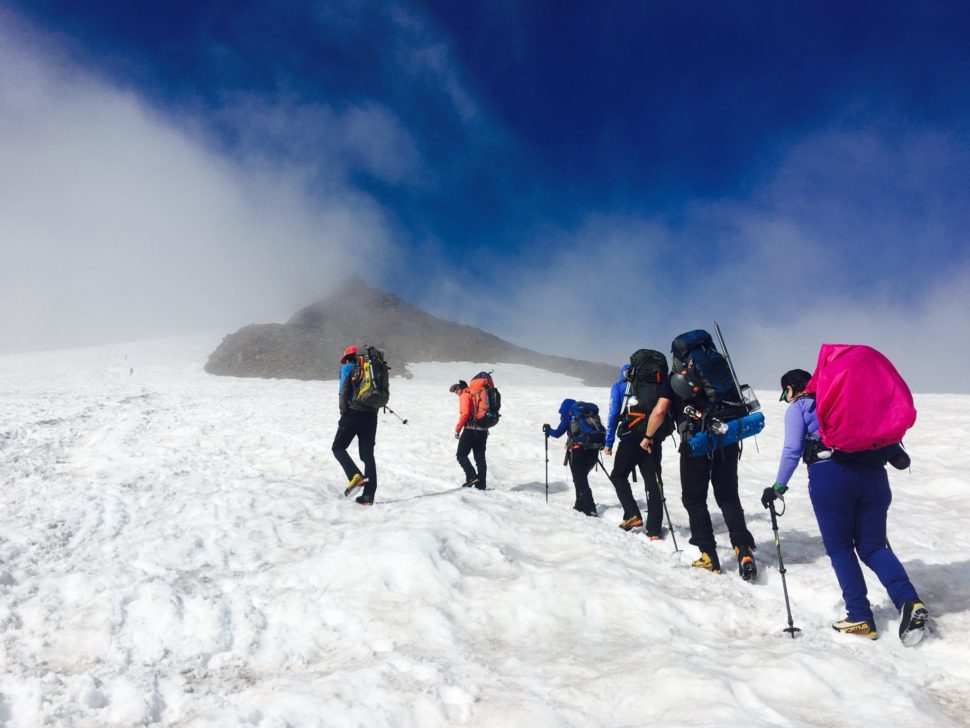
Meet The 2018 Climbers
Each person that goes through our program has a unique story. We wanted to take this opportunity to introduce you to each of our 2018 Climbers.
Meet Tyra

Tyra | Seattle Women
A Seattle native, 26-year-old Tyra found her way to Recovery Beyond after hitting rock bottom. “I was hopeless, and living in a car,” she said, “I was pregnant with my second child and fighting to get my oldest back.” Staying clean and sober with support from colleagues and staff at the program has opened up new doors for her, and she is optimistic about the continued opportunities she will experience in this program. “This is an amazing opportunity and staying clean will bring more opportunities like this my way.”
Meet Nicky

Nicki | Seattle Women
41-year-old Nicky hails from Sartell, Minnesota and has lofty goals for her life in and beyond the recovery program. “[I want] to climb Mt. Rainier, run Ragnar, Sparta, and a half marathon.” Besides these incredible physical feats, she wants to help remedy her relationship with her family and find peace within herself through the support network of Recovery Beyond and the strength of her own spirit. There is no doubt that her passion, faith, and desire for change will help her achieve these goals and more as she strives to become “more of who God designed me to be.”
Meet Michelle

Michelle | Seattle Women
Hope and acceptance are two of the most quintessential human desires – something we all search for in moments both big and small. Hope is also what drew Michelle, a Californian transplant, to the Recovery Beyond program. “[I have] a need to know that I am not useless and unloved. I hope to learn to not hate who I became, and to learn how to be happy and live life to the fullest,” she says. Staying sober with the support of the climb team and building a foundation of healthy friendships offers her that beacon of hope – of finding her own value and learning who she is in Christ.
Meet Sarah

Sarah | Tacoma Women
For Sarah, a native of Spanaway, motherhood was the best motivation to turn her life around. “I have these two beautiful children that I wasn’t being the best mom I can be to so I was willing to try anything,” she said of joining the Climbing Out climb team. 30-day-programs had failed her before, and she had to hit rock bottom before finding her way here. “[The Climb Team] is a commitment I’m sticking to!” she says, “It is a healthy replacement that gets me motivated to be strong and healthy.” Her goals outside of the climb itself include pursuing a career as a substance abuse counselor while exploring God’s truths and plans for her.
Meet Julie

Julie | Tacoma Women
30-year-old Julie from Parkland, WA takes a God-centered approach to her climb. She feels a closer relationship with God brought her into the program and will continue to guide her through the challenges and trials ahead while she builds relationships with others and grows to “be a light in the world.” When asked why she wanted to join the climb team, Julie replied, “Going through things you never thought you’d go through will only take you places you’d never thought you’d go,” an apt message about climbing mountains in both the physical and emotional world.
Meet Jessica

Jesica | Tacoma Women
Jessica of Puyallup believes that God brought her to the Climbing Out Program. “I needed to get clean and sober so I wouldn’t lose my children, so I wouldn’t lose my relationship with God, who loves me unconditionally even through my dark days. He brought me to the program.” Along with pushing herself physically for the climb, she hopes to maintain awareness and control over her addiction while rebuilding relationships with her family members. She is particularly excited about working together with the climb team, saying, “I get to be around other people going through similar things, and I get to step outside my comfort zone, and push my body in ways that it’s never been pushed. The climb team is a beautiful group of people there to encourage each other.”
Meet Colin

Colin | Seattle Men
Originally from Sacramento, CA, Colin believes the physical challenge of training for the climb and becoming physically fit will be a source of support in his recovery. He came to the program after growing tired of the life he was living, and hopes to get sober and make changes in his life.
Meet Chris

Chris | Seattle Men
At the age of 27, Seattle native Chris has already lived through more than many, including a stretch of homelessness and drug addiction that “nearly took my life,” he says, “After me realizing that 3 years had gone by and I had freely given away everything for that next high, I knew I needed a change and that change had to include God in my life.” He came to the Climbing Out program seeking a better relationship with God, a foundation in sobriety, and hoping to climb mountains and someday run marathons. He considers the fellowship of the program to be one of its major strengths. “Being a part of something bigger than yourself is a true blessing.”
Meet Joe

Joe | Seattle Men
Joe, a 28-year-old hailing from Longview, started using painkillers at a young age, which quickly turned to using heroin and nearly landed him on the streets. To avoid homelessness, a former counselor recommended he seek out the services of the mission, and the rest is history. He hopes to use the Climbing Out program to build a strong network of sober support, build a relationship with God, and mend his relationship with his family. “Through the climb team I’m able to meet many people in recovery, have spiritual experiences in nature, and instill discipline,” he says.
Meet Edward

Edward | Seattle Men
48-year-old Seattle native Edward hopes to use the recovery program to make significant changes in his life, ranging from strengthening his relationship with God to finding and securing housing and a job. His experience with the climb team is helping him learn teamwork and discipline. “The training is great experience,” he says.
Meet Christian

Christian | Seattle Men
Christian hails from Auburn, Washington, and is using the recovery program to dig at the roots of his addiction in hopes of creating lasting change. His goals include getting his depression under control, digging into how his thinking processes influenced his life circumstances, and learning more about religion and how it has and will impact his life. He looks forward to working with, learning from, and gaining inspiration from his teammates. Of the climb program itself, he says, “It is a healthy hobby that is fun and inspiring to go along with some of the more heavy psychological things I am working on. [It] gives me a feeling of accomplishment as I work on personal goals.” The intentionality with which Christian pursues his recovery are sure to serve him and his teammates well along the way.
Meet Tom

Tom | Seattle Men
Tom, a 27-year-old from Bothell, found his way to the Climbing Out program offered by Recovery Beyond after a scary wake-up call. “I relapsed and ended up in the ER with alcohol poisoning,” he said. He hopes that with the help and support of the CADRE program he will be able to maintain sobriety through the course of the program and beyond. Tom is looking forward to the climb, saying, “It gives me a fun goal to work towards, and a once in a lifetime experience.”
Meet Jason

Jason | Tacoma Men
22-year-old Jason was raised in Las Vegas and cites family as a major motivator for him in the recovery program. “My mother was struggling and trying to help me at the same time,” he says, “I’m not the uncle, brother or son that I want to be.” He struggled to find work due to his addiction, and hopes that with the recovery program he will be able to find a career to pursue and further his education. Jason’s compassion shines through when he speaks about hiking with the climb team. “I like to stay back with people who struggle a little bit because I believe it helps to have someone with you motivating them.” To him, the recovery program represents a change to continue to forge these meaningful connections with others and a new lease on life. “To me, I wasn’t present in my own life. I would be alone forever if I didn’t come here.”
Meet Chris

Chris | Tacoma Men
Chris is a Tacoma native who has hopes of someday pursuing a career in fire and rescue. With the help of the climb team and recovery program he hopes to boost his self-esteem, discover new coping mechanisms, and focus on tools to build better relationships with others.
Meet Stephen

Stephen | Tacoma Men
Stephen is a 40-year-old local who is working on centering himself and his life around God. He was brought to the program in hopes of bolstering his recovery from alcoholism and to become a better father and husband. He hopes the climb team will help him build better relationships with people by building trust and learning to work as a team to achieve goals.
Meet Jason

Jason | Tacoma Men
Born to a preacher in Burien, Jason credits his early success in life to his foundation in faith, one he hopes to return to through the recovery program. Of his life, he says, “Due to my imperfections and following temptations I became aware I had no more ability to manage success in a responsible way. I needed help, & by my faith, I think it brought the Mission to me.” By building his faith in the company of like-minded others on the team, he hopes to access a new level of spirituality. He sees the climb as both a physical and metaphorical opportunity to rise above. “I will literally have the opportunity of a lifetime, to experience in a physical and mental way, the epic goal & reward of reaching a mountain top!” he says, “My success depends on similar principles to my recovery.”
-
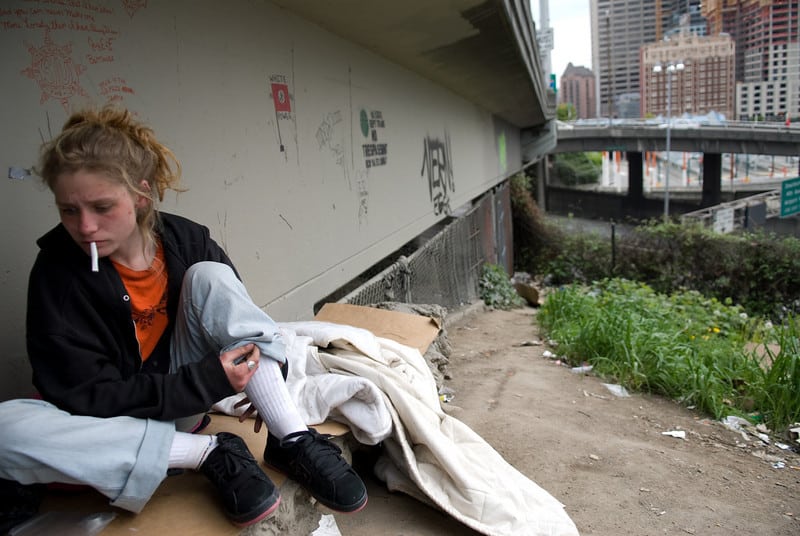
NOT Going Home – Homelessness Shows No Signs of Going Away
Image courtesy of The Gospel Herold.
On November 17th right before Thanksgiving, the Puget Sound Business Journal published a set of articles about recent reports about Homelessness in the Seattle area. There were several take aways:
- Homelessness is growing; the causes and issues are complex, and few solutions have worked.
- The government agencies that are accountable for addressing the issues caused by homelessness do not work together coordinating programs, services or budgets. A result is a silo approach which provides a variety of opportunities for people to fall through the cracks; unable to get the help they need to get off the streets.
- Often homelessness is a byproduct of the rapid rise in rents and the low number of affordable housing units available; job loss or a medical issue; with single-parent families being among the hardest hit and with the fewest options for shelter and support.
- The homeless population is straining the city and county budgets and resources at current levels; the growing numbers have decision makers very concerned about the near future. There isn’t a concise method of even reporting all the costs involved with the impacts of homeless individuals. Current measurement methods do not capture the cost causers across organizations and agencies. One article highlights the $746 million spent on a “disjointed patchwork” of programs; which include money donated to non-profits that deal with part of the problem. No one group provides services for all levels of need. See “Levels” chart below.
- The report also calls out the myths surrounding homelessness. The Seattle Report cited the following examples:
- 90{637c4c527fde39f83a380e19107d2ba88ad72607f37ccf8f8b7edeff1c20688c} – Of homeless individuals said they would move into affordable housing if available.
- 41{637c4c527fde39f83a380e19107d2ba88ad72607f37ccf8f8b7edeff1c20688c} – Of homeless individuals said they were working full or part-time with some employed in temporary and seasonal positions.
- 30{637c4c527fde39f83a380e19107d2ba88ad72607f37ccf8f8b7edeff1c20688c} – Of homeless individuals noted that job loss was the primary reason they were on the street.
- 70{637c4c527fde39f83a380e19107d2ba88ad72607f37ccf8f8b7edeff1c20688c} – Of homeless individuals said that they could only afford $500/month for rent.
- 258 – The number of people added to the homeless population each time rents increased 5{637c4c527fde39f83a380e19107d2ba88ad72607f37ccf8f8b7edeff1c20688c}.
- Homelessness is rooted in shortcomings of other systems, such as foster care, incarceration policies, mental health practices and general drug and alcohol addiction crises. A general lack of mental health providers and case managers were also cited.
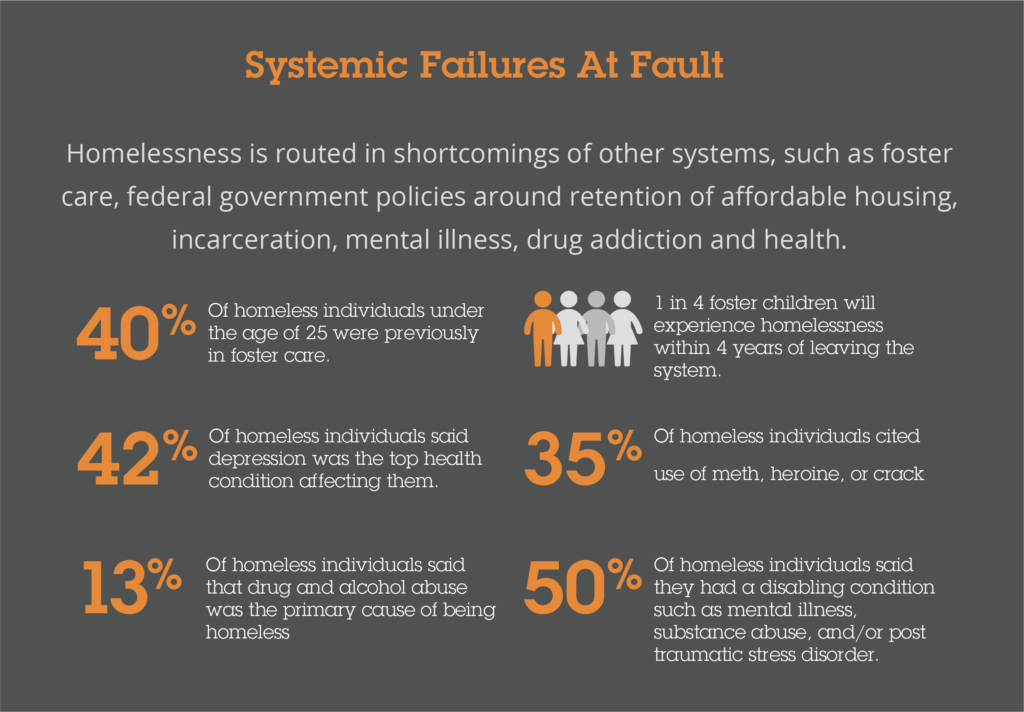
Annual Homelessness Count
Each year a count is taken to determine the homeless population in the Seattle, King County area, please see chart below for the last seven years. The previous four years have seen dramatic growth across the region. One report showed the about 40{637c4c527fde39f83a380e19107d2ba88ad72607f37ccf8f8b7edeff1c20688c} of our homeless population are not originally from the Seattle – Tacoma area.
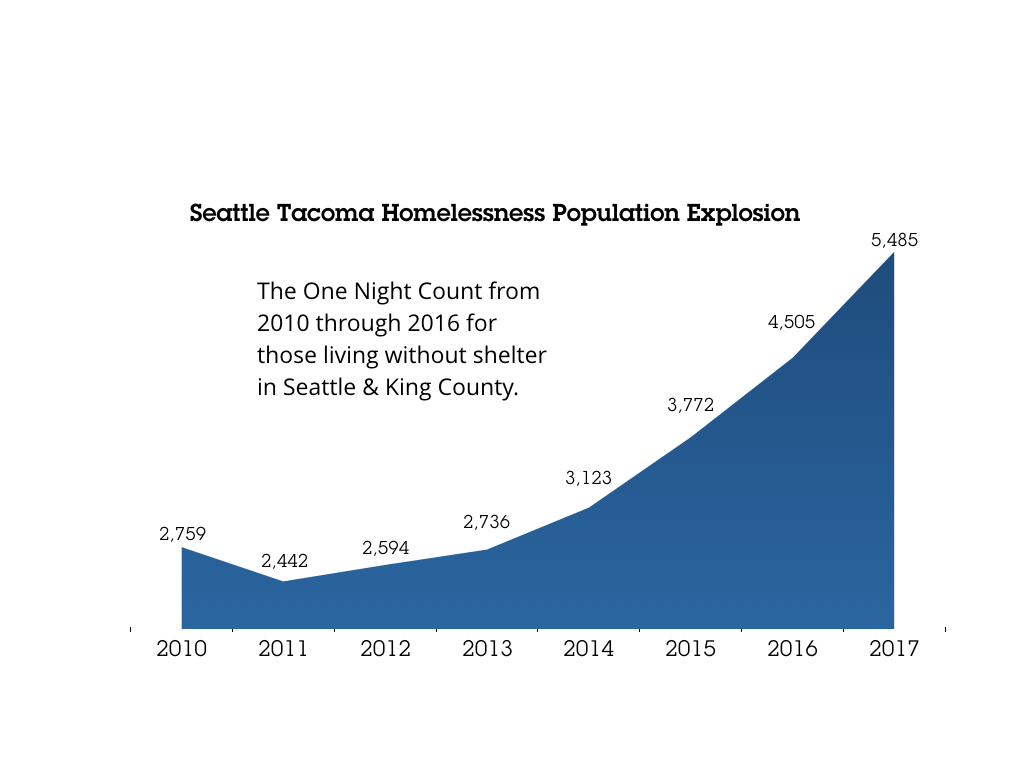
On the east side, the number of homeless families has grown tragically. There are no homeless shelters which cater to families with young children currently on the east side. A new family day shelter opened about a year ago. If money can be raised and property found, the hope is that this shelter would expand to offer year-round full time living options. By using a coordinated approach, over 40 families have found transitional or permanent housing and have moved off the streets.
Seattle’s new Mayor Jenny Durkin is quoted as saying “We are this prosperous city in the most prosperous country of the world and yet we have thousands of people sleeping in tents and doorways. We need to do better”. We believe we can do better.
Community Impacts
Homelessness is a community problem, systemic inefficiencies, the opioid crisis, and the increased number of deaths due to overdosing impacts everyone. Violent crimes are up; homeless people get sick more often and burden the healthcare system. The cost to treat someone from the streets is four times higher than someone with a home. Other data provided additional grim realities:
- Estimates show that 12,000 homeless people live in King County’s six sanctioned encampments. There are 400 other unsanctioned encampments, many living in cars or in overnight shelters.
- $1.06 billion is spent annually in Puget Sound to respond to homelessness and its issues.
- The estimated cost of house and care for our homeless would be $192 million a year.
- None of the costs mention includes those incurred by the Seattle Police Department or Harborview. Public agencies don’t uniformly track costs; so it is difficult to see the whole picture.
- There is no system to identify the homeless; so they may end up being recycled through the medical system and jails without ever getting them the help they need, for example, mental health prescriptions or addiction treatment. Washington State ranks 47th in the nation for access to mental health services according to Mental Health America.
- The US Department of Housing has not allocated a penny for public housing since 1996. Future budgets are not hopeful either.
Solutions
The only real sustainable solution is prevention. By preventing people from falling through the systemic support cracks, we could prevent homelessness in the future. But first, there is still a lot to learn about the causes and issues around why people end up on the streets right now. This problem is an individual one; each person comes with their own story. Each story has implications for a different set of circumstances, root causes. A plethora of possible changes would be necessary to address these outcomes and alter their results. One approach is developing services, providing case management resources and additional funding safety nets to help vulnerable people and their families. It also means being ready to tackle upstream problems. There is little doubt that it would be cheaper and less traumatic if we could stop homelessness from ever occurring; rather than treating it as we are today.
Addiction may be the most important root cause today, especially with the growing opioid problems across the country. Possible solutions would need to include:
- Additional treatment centers and increased number of beds for those ready to enter treatment. Until the individual is prepared to address the causes of their addiction, their behavior won’t change.
- The small number of affordable or low rent housing units and rapidly rising rents mean that more people with little or no earning power are at risk. This is especially true for those with disabilities or limited capacity.
- Often transitional housing is the first step toward re-entering society; job training, counseling, medical services are all part of the safety net to keep people off the streets. Social services that offer case management support are the quickest way to assure all the issues are being identified and an action plan developed and monitored to alleviate problems and keep them from repeating.
- Some large and small employers are beginning to work together to supply part of the missing services. This is a sign of hope. It also allows them to find valuable future employees once underlying issues have been addressed and job training or needed skills are gained.
Why do we care? We see the spectrum of need and fill a small role in assisting people in their recovery process by offering physical fitness, companionship, and mentoring to develop the socialization skills necessary to be part of the team and to learn to set goals, helping our recovery participants to succeed. By working with mission partners, we augment the treatment program they offer. We’ve measured our results over the last three years and have seen an 85{637c4c527fde39f83a380e19107d2ba88ad72607f37ccf8f8b7edeff1c20688c} sobriety rate. We believe that after seven years, we are ready to help more people in our community to find the healing and peace they need. Our community will be better off as a result of a more coordinated individual approach and by building the safety net many need. We aren’t giving a hand out; we’re helping by providing a hand up. Please consider how you can help. After all, we are in this together.
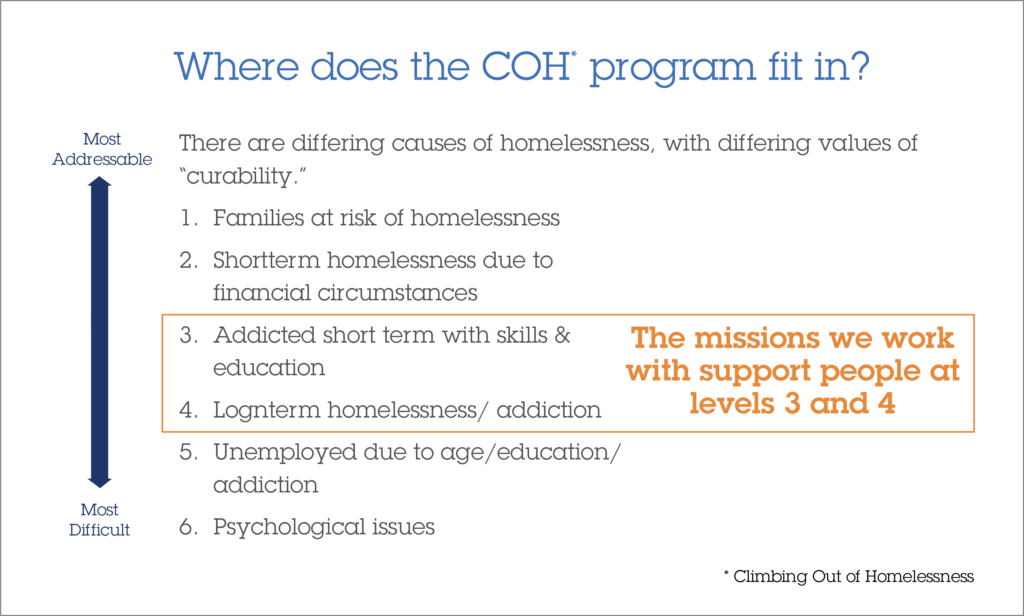
The Truth About Homelessness (Infographic)

-

Make An Impact This #GivingTuesday
Helen Keller said – “Alone we can do so little; together we can do so much”
We do have so much to be grateful for. #Giving Tuesday is a follow-up to the mass purchasing behavior we exhibit on Black Friday and Cyber Monday. Its purpose is to focus our attention on deserving non-profits who do so much to help our community; more than we know or can calculate. It’s a two-way street, we support them and they provide an outlet for issues we are passionate about, but may not have the time to get actively involved with. Regardless of your reasons, supporting these groups provides for needs that otherwise would go unmet. People depend on non-profits to fill the gap left where social services offered by our government agencies leave off. These same non-profits depend on public donations to keep their doors open and welcome those in dire straits.
This year we are proud to be part of that group of non-profits providing a lifeline to those trying to escape the pull of addiction; people who don’t have anywhere else to turn. Like other non-profits, we can’t survive without the generosity of people of good will. People who know that by becoming a more caring community we can do tremendous things.
Why is giving a good thing? The heart is a muscle that needs to be exercised to be healthy and working up to capacity. Our ability to give is one measure of how well our heart (and conscious) is working. There have been many studies touting the benefits of giving and volunteering time; apart from the physical and emotional benefits, the connections we make are very rewarding for those we serve. These social connections are very good for us, too. They keep us engaged and learning; while providing support for others, they help us gain or strengthen skills. During the holiday season, it’s good to assess where we are giving and where we could be giving more of our treasure or our time. It is ‘with and through community’ that we can make the largest impact; where we can share the wisdom we have gained and offer consolation for those who are working to regain control of their lives.
Please consider the many ways you can become part of our Community of Compassion. Compassion is defined as sympathetic consciousness of others’ distress together with a desire to alleviate it. Recovery Beyond’s goal through our Community of Compassion members is to make homelessness due to alcohol or drug addiction a thing of the past. We assist with a therapeutic approach to sustained recovery and reentry into society during our 10-month program. Please find joy in giving to the non-profits of your choice. Our Climbing Out Program is one place that will make good use of your donations.
Learn more about what we do at Recoverybp.org to get involved or to get help.
Winston Churchill once said, “We make a living by what we get. We make a life by what we give.”
-
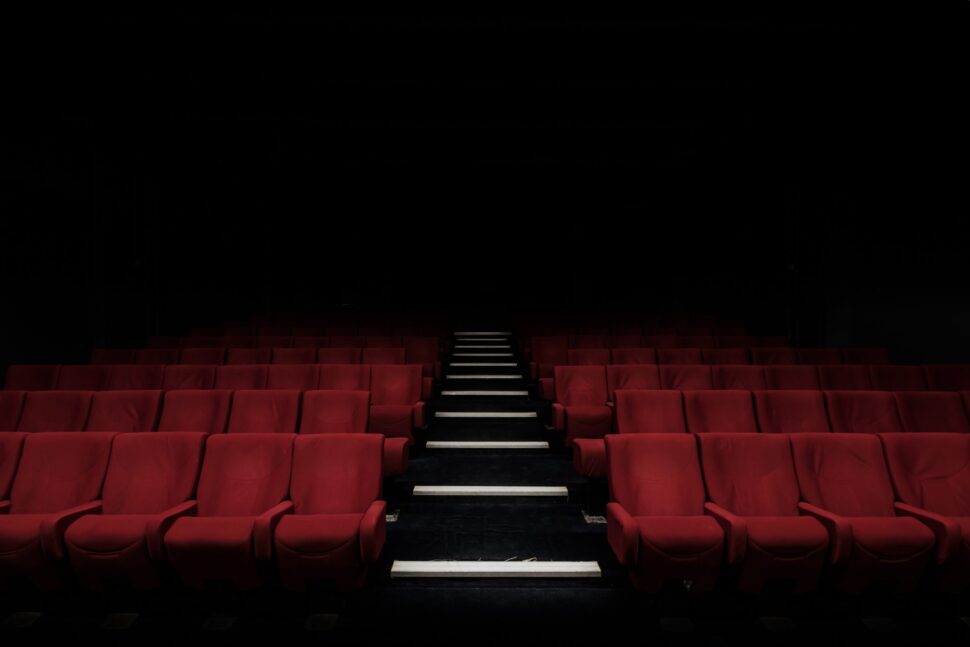
Our First Movie Night
Our first movie night was held on September 17th at Mary, Queen of Peace Church in Sammamish, Washington. This event kicks off our fundraising cycle for the next program year which begins in October.
We had the opportunity to tell the Climbing Out story to people who were very interested in helping those struggling with permanent housing and the reasons for it. Addictions of all types drag people down. Addiction destroys self-esteem, relationships and families, and causes a host of physical, emotional and mental problems. The Climbing Out program offered by Recovery Beyond offers a holistic approach to the needs of each individual. This approach addresses the priorities in the next stage of treatment and recovery. Working with our partner missions, we can accomplish more in the year or two when we join together in working with clients.
Our volunteers and mentors walk the journey with our clients as friends and a source of wisdom, experience, and support. These relationships are a very significant part of achieving long-lasting results. We can’t thank our volunteers enough for the love and care they provide.
While we are still developing a full set of metrics to track progress and overall success, we know that the Climbing Out program works because our clients are the proof. Not only do they complete their treatment program, but many come back joining next year’s program as a volunteer and mentor; supporting others through the perilous journey to sobriety. This Community of Compassion is what you join when you support us with your ongoing gift of time, treasure or equipment.
Some of the program participants attended this event; sharing their story and the impact the program had in their lives. We hope that this message of hope shared through personal stories in the film will foster increased giving offering grow the programs Recovery Beyond sponsors.
Make A Donation Today! -
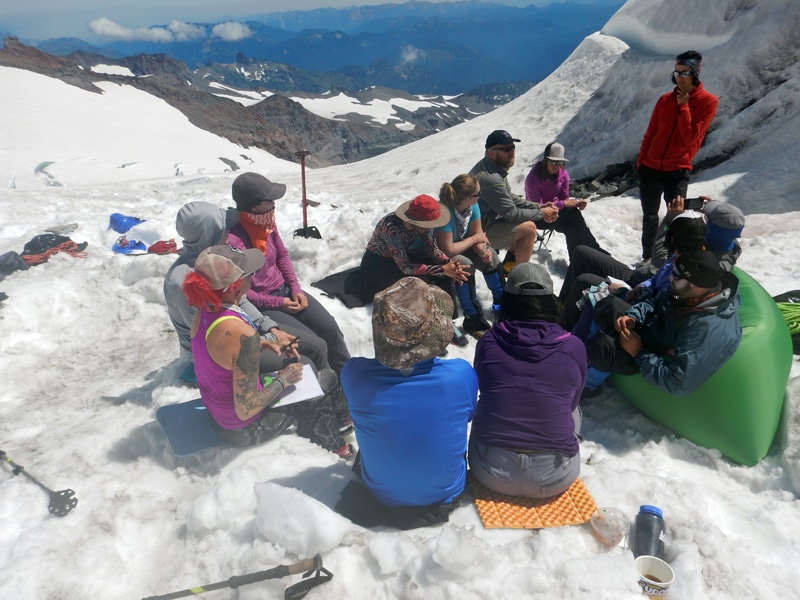
Going Home – Seattle’s Union Gospel Mission
They say ‘you can never go home’, but that’s exactly what we are doing. This fall the Climbing Out of Homelessness Program will return to Seattle’s Union Gospel Mission. Our partnership with UGM began in 2011, based on a need to enhance the addiction recovery program. Taking a crazy idea that shakes up the perception of people by endeavoring to climb a mountain. Little did we know at the time, what a great metaphor that would become, both figuratively and literally. This isn’t just another physical fitness program; it’s a community way of helping our neighbors overcome the challenges of all types of addiction. Help us celebrate this homecoming by making a tax deductible donation today.
-

Join our Community of Compassion
Consider joining our Community of Compassion. By making an ongoing monthly donation of $20, you can give a new way of life for our program climbers. There are many ways to give, please see other suggestions on our website at https://recoverybp.org/how-you-can-help/
Changing the face of homelessness is really up to us. We support climbers in a number of ways. You may already be supporting one of the missions doing great work to alleviate addiction and its consequences. Our Climbing Out of Homelessness program helps make long lasting change possible. A community of compassion and support makes all the difference for the success of recovery. None of us achieve anything significant without the support of community. Our community is the key to this wonderful transformation.
-

Celebrating a New Beginning
On Saturday, August 12th our climbing team gathered for the pre-climb dinner at Wild Berry Restaurant in Ashford, Washington at the base of Mount Rainier. The next morning this jubilant group would start the final climb of the year, up 14,411 feet of Mount Rainier, one of the highest peaks in the continental US.
To say they were excited would be a gross understatement. To say that they were amazed at the 10 months of progress they had made would be much more truthful. As a group, the program and volunteer climbers were in a state of awe. Even though the actual climb was a day away, this was the culminating event; the place where each person was recognized for how far they had come and for the truly wondrous person they were becoming.
The relationships that form on this journey of healing to wholeness are the most satisfying and predictable part of the transformation each person has undergone. I chose this headliner quote from Matthew Kelly because it sums up the essence of our whole approach to partnering in the treatment and therapy that each person needs to find during their recovery process toward the life they were meant to live. Truly “when we reveal our faults and failings, … people do begin to love us” and at a much deeper level. Perhaps even for the first time in our lives.
“When we reveal our faults and failings, … people do begin to love us” – Matthew Kelly
Maybe in a way that we are now more prepared to accept; in our brokenness we begin to understand why we need each other. The love expressed was deeply humbling and beautifully expressed. Sometimes it’s in the little things that happened during preparatory events or it was in the deep bond that had formed from personal needs being meant on both sides of the relationship. Other times it was in the deep and trusting bond that helped someone realize the potential for good they had inside.
The value of each life and the contribution one can make, no matter when you start. The realization was a huge part of the transformative process the Climbing Out program tries to offer.
The mere fact that ‘strangers’ bonded so completely and that the transformations we witness are so astounding, is a blessing. A blessing for all who are part of this program and who are able to view the changes, the challenges and glorious successes our climbers spoke about Saturday night.
Life is very hard for someone who ends up on the streets homeless after experiencing the tragic impact of drug or alcohol abuse. This outcome is not what they planned or even what they wanted; but the ability to climb out of that situation takes the same drive, guts and effort that is does to climb a 14,000 foot mountain.
As a society, we do not make it any easier for them either. As a society, we are to blame oftentimes for the series of blows that causes someone to fall this far; and we are also responsible for providing the solutions to help this pattern be reversed; to even prevent it from happening to others to begin with.
Recovery Beyond’s mission is “To develop, fund, and deliver programs, services, or items that complement the efforts of established recovery/homelessness programs in unconventional ways.”
We ask you to join our Community of Compassion by becoming involved, by helping us continue to expand and offer programs that actually are getting results to help even more people and offered through more missions. Please visit our donate page to see who you can be responsible for delivering winning solutions.
More about the climb’s outcome in our upcoming newsletter and later blogs. Sign up to receive our newsletter below.
Make An Impact, Get Involved. Change Lives Today.
Photo credit: Art Wolf
-

Taking Care of The Big Rocks
Recovery is what we are all about, developing the right physical, emotional, relational and spiritual framework with a good measure of resilience to keep addictive behaviors in check. While each person’s path to recovery is unique, there are certain actions that determine the overall success of treatment and the endurance needed for long-term recovery.
Recovery Beyond works in partnership with missions who offer drug, alcohol and other addiction recovery programs. We focus on the other gradients of the individual’s life not covered by the missions to help participants understand and heal the causes and effects of past behaviors, friendships and social structure that led to their current situation. This process assists in determining what is helpful and not helpful in moving forward to a life of sobriety. Oftentimes people just need to learn how others cope with life’s messiness. No one has a simple life; trouble goes hand in hand of living as a human being. Everyone experiences pressures, failures, trials and disappointments; we all need to learn how to negotiate these pitfalls and to grow as a result. It’s the decisions we make and the actions we take that determine whether we come through the experiences stronger and better prepared to live well. This does not happen all by itself.
I like to think about this as taking care of the ‘big rocks’; the really important things in life; the areas we need to experience before we can grow. Recent research we undertook with past program participants found that a high percentage struggled with spiritual issues. This struggle produced a great deal of uncertainty, doubt and insecurity which eventually lead to abusing alcohol, drugs or involvement in other addictions.
We can’t always see beyond the big rocks, even when they are right in front of us. Sometimes just recognizing what they are is a major challenge all on its own. We need people who love us to mentor and provide wisdom or insights into what is happening and why. Sharing a personal story is the best way to relate and work through the work of unraveling the tangled web weaved in error. That’s why what we have been doing for six years has obtained very respectable results; the last three years measured at 85% sustained sobriety. It truly is taking one day at a time and asking for help when life becomes overwhelming. Our community of caring replaces damaged relationships or dysfunctional family patterns and allows a path to nurturing healthy relationships and building a new support system.
So what can you do to help?
We are expanding to another mission in the fall; watch for an upcoming Recovery Beyond ‘Movie Night’ this fall, where we share the story of our 2013 climb and the lives of those who addressed life’s big rocks. Some will be present to talk about their journey.
Recurring donations is the easiest and best way to become part of our team. Other ways to give include:
- Donating new or gently used climbing equipment and clothing. Everything our climbers use is either donated or purchased for them. See our website for ideas and the types of equipment needed.
- Time – we have a strong group of dedicated volunteers who help on the all the outings to get climbers ready for the major events and to exercise or work out to assure the endurance needed to climb mountains. As we expand to another mission, there will be more openings available.
- Encourage one of our program climbers; our website makes it easy to reach out share your story and help someone else lead a more fulfilling life.
- Finally, pray for each person’s success. Remember the spiritual hole is usually the hardest one to fill. It is in the love shown daily by our wonderful team of volunteers that leads others to developing a life of faith and a means to putting the big rocks in the right order.
Please join us today.
“The single biggest variable that’s correlated with adult homelessness is childhood maltreatment, childhood abuse, abandonment, trauma and neglect.” Mike Johnson – Rachel Belle article, July 27, 2016
-

KIRO Radio, The Ron and Don Show Features Climbing Out Of Homelessness
Recovery Beyond Featured On

On the June 12, 2017 broadcast of The Ron and Don Show on KIRO Radio in Seattle, the Climbing Out program was highlighted. You can listen to the broadcast below. Forward to 19:40 for the story on our amazing program.

Author archive for Gina Haines
Recovery Beyond > Articles by: Gina Haines
